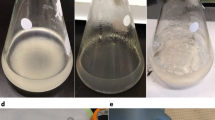Abstract
Purpose
We have previously shown that ultrasound-mediated transfection (sonotransfection) can be optimized using a concept based on the ultrasound-induced apoptosis produced in our in vitro experiments. At optimized conditions, we have shown, using five cancer cell lines, that sonotransfection is superior to other conventional nonviral methods. Interferon gamma (IFN-γ) transfection using lipofection has been found to markedly inhibit the proliferation of neurofibroma cell lines. In this study, we investigated whether sonotransfection of IFN-γ to neurofibroma cell lines can suppress cell proliferation.
Methods
The ultrasound device used was the SonoPore KTAC-4000, which is capable of various acoustic settings. Ultrasound transducers at an oscillation frequency of 1.011 MHz were used; the potential ideal conditions were an intensity of 0.17 W/cm2 at a burst frequency of 0.5 Hz, 25% duty factor, and 30-s sonication duration. Cells were assayed at 3 and 5 days after sonication.
Results
The transfection efficiency was found to be 12%. The ultrasound-treated cells were successfully transfected with IFN-γ genes as detected by enzyme-linked immunosorbent assay, and the cell growth ratio in the IFN-γ sonotransfection group tended to be lower than that in the other experimental groups.
Conclusion
These results suggested that IFN-γ sonotransfection could potentially become a nonsurgical method for treating skin lesions such as neurofibromas.
Similar content being viewed by others
References
Wilson DR. Viral-mediated gene transfer for cancer treatment. Curr Pharm Biotechnol 2002;3(2):151–164.
Bloquel C, Fabre E, Bureau MF, et al. Plasmid DNA electrotransfer for intracellular and secreted protein expression: new methodological developments and applications. J Gene Med 2004;6Suppl 1:S11–S23.
Uesato M, Gunji Y, Tomonaga T, et al. Synergistic antitumor effect of antiangiogenic factor genes on colon 26 produced by low-voltage electroporation. Cancer Gene Ther 2004;11(9):625–632.
Kikuchi A, Aoki Y, Sugaya S, et al. Development of novel cationic liposomes for efficient gene transfer into peritoneal disseminated tumor. Hum Gene Ther 1999;10(6):947–955.
Yamashita Y, Shimada M, Tachibana K, et al. In vivo gene transfer into muscle via electro-sonoporation. Hum Gene Ther 2002;13(17):2079–2084.
Kennedy JE. High-intensity focused ultrasound in the treatment of solid tumours. Nat Rev Cancer 2005;5(4):321–327.
Feril LB Jr, Kondo T, Umemura S, et al. Sound waves and antineoplastic drugs: the possibility of an enhanced combined anticancer therapy. J Med Ultrasonics 2002;29(4):173–187.
Feril LB Jr, Kondo T. Biological effects of low-intensity ultrasound: the mechanism involved and its implications on therapy and on biosafety of ultrasound. J Radiat Res 2004;45(4):479–489.
Nozaki T, Ogawa R, Feril LB Jr, et al. Enhancement of ultrasoundmediated transfection by membrane modification. J Gene Med 2003;5(12):1046–1055.
Lawrie A, Brisken AF, Francis SE, et al. Ultrasound-enhanced transgene expression in vascular cells is not dependent upon cavitation-induced free radicals. Ultrasound MedBiol 2003;29(10):1453–1461.
Newman CM, Lawrie A, Brisken AF, et al. Ultrasound gene therapy: on the road from concept to reality. Echocardiography 2001;18(4):339–347.
Ogawa R, Kagiya G, Feril LB Jr, et al. Ultrasound mediated intravesical transfection enhanced by treatment with lidocaine or heat [comment]. J Urol 2004;172(4 Pt 1):1469–1473.
Taniyama Y, Tachibana K, Hiraoka K, et al. Development of safe and efficient novel nonviral gene transfer using ultrasound: enhancement of transfection efficiency of naked plasmid DNA in skeletal muscle. Gene Ther 2002;9(6):372–380.
Tachibana K, Uchida T, Ogawa K, et al. Induction of cell-membrane porosity by ultrasound. Lancet 1999;353(9162):1409.
Feril LB Jr, Ogawa R, Tachibana K, et al. Optimized ultrasound-mediated gene transfection in cancer cells. Cancer Sci 2006;97(10):1111–1114.
Nakashima M, Tachibana K, Iohara K, et al. Induction of reparative dentin formation by ultrasound-mediated gene delivery of growth/differentiation factor 11. Hum Gene Ther 2003;14(6):591–597.
Baque P, Pierrefite-Carle V, Gavelli A, et al. Naked DNA injection for liver metastases treatment in rats. Hepatology 2002;35(5):1144–1152.
Ng KY, Liu Y. Therapeutic ultrasound: its application in drug delivery. Med Res Rev 2002;22(2):204–223.
Sakakima Y, Hayashi S, Yagi Y, et al. Gene therapy for hepatocellular carcinoma using sonoporation enhanced by contrast agents. Cancer Gene Ther 2005;12(11):884–889.
Nakayama J, Tanaka T, Arakawa F, et al. Gamma interferon gene transfection efficiently inhibits proliferation of neurofibroma cell lines in vitro. J Dermatol 2003;30(3):181–188.
Nakayama J, Terao H. Gamma interferon directly inhibits the growth of neurofibroma cells in vitro. J Dermatol 2002;29(9):556–561.
Lalani AS, Chang B, Lin J, et al. Anti-tumor efficacy of human angiostatin using liver-mediated adeno-associated virus gene therapy. Mol Ther J Am Soc Gene Ther 2004;9(1):56–66.
Shinozaki K, Ebert O, Kournioti C, et al. Oncolysis of multifocal hepatocellular carcinoma in the rat liver by hepatic artery infusion of vesicular stomatitis virus. Mol Ther J Am Soc Gene Ther 2004;9(3):368–376.
Armeanu S, Lauer UM, Smirnow I, et al. Adenoviral gene transfer of tumor necrosis factor-related apoptosis-inducing ligand overcomes an impaired response of hepatoma cells but causes severe apoptosis in primary human hepatocytes. Cancer Res 2003;63(10):2369–2372.
Yotnda P, Davis AR, Hicks MJ, et al. Liposomal enhancement of the antitumor activity of conditionally replication-competent adenoviral plasmids [published erratum appears in Mol Ther 2004;10(2):404]. Mol Ther J Am Soc Gene Ther 2004;9(4):489–495.
Author information
Authors and Affiliations
Corresponding author
About this article
Cite this article
Yamaguchi, K., Feril, L.B., Harada, Y. et al. Growth inhibition of neurofibroma by ultrasound-mediated interferon γ transfection. J Med Ultrasonics 36, 3–8 (2009). https://doi.org/10.1007/s10396-008-0204-0
Received:
Accepted:
Published:
Issue Date:
DOI: https://doi.org/10.1007/s10396-008-0204-0




